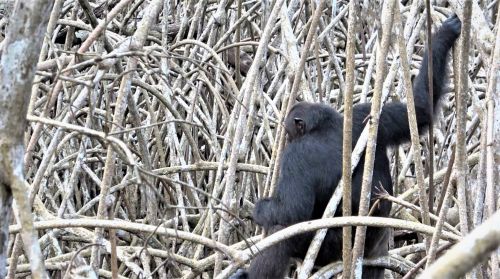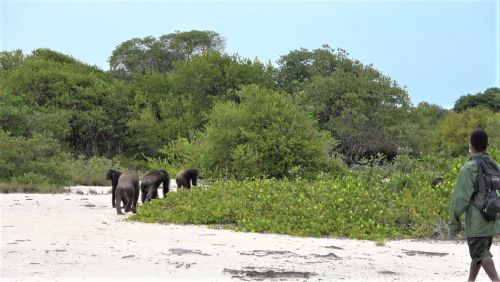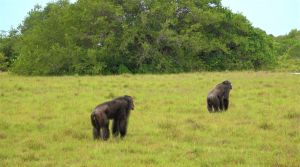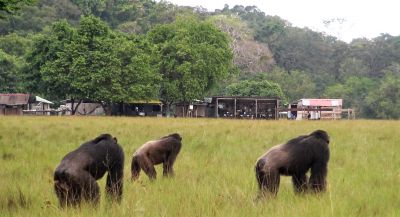Difference between revisions of "Loango National Park"
| (11 intermediate revisions by one other user not shown) | |||
| Line 17: | Line 17: | ||
* Key threats to great apes include poaching, disturbance due to tourism and human presence and oil exploration. | * Key threats to great apes include poaching, disturbance due to tourism and human presence and oil exploration. | ||
* Conservation activities have focused on anti-poaching patrols and involving local communities in research activities. | * Conservation activities have focused on anti-poaching patrols and involving local communities in research activities. | ||
| − | |||
= Site characteristics = <!-- A paragraph summary of physical and geographic aspects of the site, and a table of key information --> | = Site characteristics = <!-- A paragraph summary of physical and geographic aspects of the site, and a table of key information --> | ||
| Line 69: | Line 68: | ||
= Threats = <!-- a text overview of threats, followed by a table of key threats --> | = Threats = <!-- a text overview of threats, followed by a table of key threats --> | ||
| − | + | [[File:Chimpanzees loango savanna.jpg | 300px | thumb| right | © Lara Southern]] | |
Gabon boasts an important store of natural resources, the most prominent being oil. In 2006 and 2007 a petroleum company conducted seismic exploration inside Loango National Park (Rabanal et al. 2010). It has been shown that the most common behavioral change exhibited by wildlife to intense human-produced noise is active avoidance. The study modeled seismic impact over different spatial scales (small, intermediate and large) and found that apes avoided seismic activity on the intermediate and small scales (REF). | Gabon boasts an important store of natural resources, the most prominent being oil. In 2006 and 2007 a petroleum company conducted seismic exploration inside Loango National Park (Rabanal et al. 2010). It has been shown that the most common behavioral change exhibited by wildlife to intense human-produced noise is active avoidance. The study modeled seismic impact over different spatial scales (small, intermediate and large) and found that apes avoided seismic activity on the intermediate and small scales (REF). | ||
Additionally, hunting, although relatively non-existent around the study site, may pose a threat to ape populations in other areas of the park such as the forest inlets boarding the lagoon (REF). | Additionally, hunting, although relatively non-existent around the study site, may pose a threat to ape populations in other areas of the park such as the forest inlets boarding the lagoon (REF). | ||
| Line 179: | Line 178: | ||
= Conservation activities = <!-- A summary of the conservation activities, followed by a table of key activities --> | = Conservation activities = <!-- A summary of the conservation activities, followed by a table of key activities --> | ||
| − | [[File: chimpanzee loango camp.jpg | | + | [[File: chimpanzee loango camp.jpg | 400px | thumb| right | © Lara Southern]] |
In 2005 the first research camp was set up as a Pan African Programme (PanAf) study site, and this later became the Ozouga camp and base of the Loango Chimpanzee Project. The establishment of this site ensures the continued presence of researchers in the study area, which, at other sites, has been shown to have a positive influence on local chimpanzee densities (Campbell et al. 2011). | In 2005 the first research camp was set up as a Pan African Programme (PanAf) study site, and this later became the Ozouga camp and base of the Loango Chimpanzee Project. The establishment of this site ensures the continued presence of researchers in the study area, which, at other sites, has been shown to have a positive influence on local chimpanzee densities (Campbell et al. 2011). | ||
There is a strong connection and collaboration between the local people, primarily of the Miene (Myene) ethnicity, and the research site. At present, five permanent eco-guides native to the area are employed. Their direct involvement at this research site make them important stakeholders for the future of the park and the livelihood of those living around it. Additionally, educational programs and activities have been conducted in the village that borders the Northern edge of the park; these were performed in partnership with WCS (Southern pers. comm.). | There is a strong connection and collaboration between the local people, primarily of the Miene (Myene) ethnicity, and the research site. At present, five permanent eco-guides native to the area are employed. Their direct involvement at this research site make them important stakeholders for the future of the park and the livelihood of those living around it. Additionally, educational programs and activities have been conducted in the village that borders the Northern edge of the park; these were performed in partnership with WCS (Southern pers. comm.). | ||
| Line 226: | Line 225: | ||
|- | |- | ||
|8. Invasive & other problematic species, genes, diseases | |8. Invasive & other problematic species, genes, diseases | ||
| − | | | + | |Not reported |
| − | | | + | | |
| − | | | + | | |
|- | |- | ||
|9. Pollution | |9. Pollution | ||
| Line 340: | Line 339: | ||
Estienne, V. L. (2017). Tool-use technique for the extraction of underground honey by central African chimpanzees in Loango National Park, Gabon. PhD Thesis, Universität, Leipzig.<br> | Estienne, V. L. (2017). Tool-use technique for the extraction of underground honey by central African chimpanzees in Loango National Park, Gabon. PhD Thesis, Universität, Leipzig.<br> | ||
Estienne, V., & Boesch, C. (2015). Underground honey extraction by chimpanzees, honey badgers and forest elephants in Loango National Park, Gabon. Folia Primatologica, 86(4), 276-277.<br> | Estienne, V., & Boesch, C. (2015). Underground honey extraction by chimpanzees, honey badgers and forest elephants in Loango National Park, Gabon. Folia Primatologica, 86(4), 276-277.<br> | ||
| − | |||
Martinez-inigo, L., Baas, P., Klein, H., Pika, S., Deschner T. (in press). Intercommunity interactions and killings in central chimpanzees (Pan troglodytes troglodytes) from Loango National Park, Gabon. Primates. <br> | Martinez-inigo, L., Baas, P., Klein, H., Pika, S., Deschner T. (in press). Intercommunity interactions and killings in central chimpanzees (Pan troglodytes troglodytes) from Loango National Park, Gabon. Primates. <br> | ||
Rabanal, L. I., Kuehl, H., Mundry, R., Robbins, M. M., & Boesch, C. (2010). Oil prospecting and its impact on large rainforest mammals in Loango National Park, Gabon. Biological Conservation, 143(4), 1017-1024. <br> | Rabanal, L. I., Kuehl, H., Mundry, R., Robbins, M. M., & Boesch, C. (2010). Oil prospecting and its impact on large rainforest mammals in Loango National Park, Gabon. Biological Conservation, 143(4), 1017-1024. <br> | ||
| Line 346: | Line 344: | ||
<br> | <br> | ||
| − | '''Page completed by: ''' Lara Southern''' Date:''' 13/10/2021 <!-- If you don't want to add your name, you can add "A.P.E.S. Wiki team" --> | + | '''Page completed by: '''Lara Southern''' Date:''' 13/10/2021 <!-- If you don't want to add your name, you can add "A.P.E.S. Wiki team" --> |
Latest revision as of 06:37, 19 August 2024
Central Africa > Gabon > Loango National Park
Summary[edit]
- Central chimpanzees (Pan troglodytes troglodytes) & western lowland gorillas (Gorilla gorilla gorilla) are present in Loango National Park.
- The population sizes are unknown.
- The population trends are unknown.
- The site has a total size of 1,550 km².
- Key threats to great apes include poaching, disturbance due to tourism and human presence and oil exploration.
- Conservation activities have focused on anti-poaching patrols and involving local communities in research activities.
Site characteristics[edit]
Loango National Park is located in the south west of Gabon and borders the Atlantic Ocean. It consists of a mosaic of different habitat types varying from marine, coastal lagoons, mangrove swamps, coastal forest, secondary and primary forest and open savannah. It is ecologically distinct from other long-term chimpanzee sites thereby providing the rare opportunity to enable unique insights into chimpanzees’ behavioral plasticity (REF). In addition to central chimpanzees, the national park is also home to western low-land gorillas (Gorilla gorilla gorilla), forest buffaloes (Syncerus caffer), forest elephants (Loxodonta cyclotis), as well as several resident and migratory bird species, such as rosy bee-eaters (Merops malimbicus) (REF).
Table 1. Basic site information for Loango National Park
| Area | 1,550 km² |
| Coordinates | -2.118840 S, 9.605397 E |
| Designation | National Park |
| Habitat types | Subtropical/tropical moist lowland forest, subtropical/tropical mangrove vegetation above high tide level, subtropical/tropical swamp, coastal saline lagoons/marine lakes |
IUCN habitat categories Site designations
Ape status[edit]
To date there has only been one survey conducted regarding chimpanzee abundance in Loango National park. This was done through the collection of wild chimpanzee fecal samples for genetic capture-recapture analyses over a four-year period (2005-2008) in a 132 km2 area of the National Park (Arandjelovic et al. 2011).
Table 2. Ape population estimates in Loango National Park
| Species | Year | Abundance estimate (95% CI) | Density estimate [ind./ km²] (95% CI) | Encounter rate (nests/km) | Area | Method | Source | Comments | A.P.E.S. database ID |
|---|---|---|---|---|---|---|---|---|---|
| Pan troglodytes troglodytes | 2005-2008 | 283 (208 – 316) | 2.14 (1.57 – 2.39) | 132 sq.km | Capture-recapture method | Arandjelovic et al. 2011 |
Threats[edit]
Gabon boasts an important store of natural resources, the most prominent being oil. In 2006 and 2007 a petroleum company conducted seismic exploration inside Loango National Park (Rabanal et al. 2010). It has been shown that the most common behavioral change exhibited by wildlife to intense human-produced noise is active avoidance. The study modeled seismic impact over different spatial scales (small, intermediate and large) and found that apes avoided seismic activity on the intermediate and small scales (REF). Additionally, hunting, although relatively non-existent around the study site, may pose a threat to ape populations in other areas of the park such as the forest inlets boarding the lagoon (REF). Lastly, health risks related to human-chimpanzee disease transmission may be increased due to increased human presence in the park and the potential for new ecotourism ventures (REF).
Table 3. Threats to apes in Loango National Park
| Category | Specific threats | Threat level | Quantified severity | Description | Year of threat |
|---|---|---|---|---|---|
| 1. Residential & commercial development | Absent | ||||
| 2. Agriculture & aquaculture | Absent | ||||
| 3. Energy production & mining | 3.1 Oil & gas drilling | Medium | Effect of seismic oil exploration on large mammal distribution
(Rabanal et al. 2010) |
2006-2007 | |
| 4. Transportation & service corridors | Absent | ||||
| 5. Biological resource use | 5.1 Hunting & collecting terrestrial animals | Low | Signs of poacher trails in the far North of the territory (REF). | Ongoing (2021) | |
| 6. Human intrusion & disturbance | 6.1 Recreational activities | Low | Loango National park is open to tourism and therefore there is the possibility of exposure of apes to humans outside of the research area. Additionally, vehicles for safari outings may pose a disturbance to ape populations along these routes. | Ongoing (2021) | |
| 6.3 Work & other activities | Low | The very presence of the research camp itself poses a disturbance to great apes and territory avoidance may take place. | Ongoing (2021) | ||
| 7. Natural system modifications | Unknown | ||||
| 8. Invasive & other problematic species, genes, diseases | Unknown | ||||
| 9. Pollution | Unknown | ||||
| 10. Geological Events | Absent | ||||
| 11. Climate change & severe weather | Unknown | ||||
| 12. Other options | Absent |
Conservation activities[edit]
In 2005 the first research camp was set up as a Pan African Programme (PanAf) study site, and this later became the Ozouga camp and base of the Loango Chimpanzee Project. The establishment of this site ensures the continued presence of researchers in the study area, which, at other sites, has been shown to have a positive influence on local chimpanzee densities (Campbell et al. 2011). There is a strong connection and collaboration between the local people, primarily of the Miene (Myene) ethnicity, and the research site. At present, five permanent eco-guides native to the area are employed. Their direct involvement at this research site make them important stakeholders for the future of the park and the livelihood of those living around it. Additionally, educational programs and activities have been conducted in the village that borders the Northern edge of the park; these were performed in partnership with WCS (Southern pers. comm.).
Table 4. Conservation activities in Loango National Park
| Category | Specific activity | Description | Year of activity |
|---|---|---|---|
| 1. Residential & commercial development | Not reported | ||
| 2. Agriculture & aquaculture | Not reported | ||
| 3. Energy production & mining | Not reported | ||
| 4. Transportation & service corridors | Not reported | ||
| 5. Biological resource use | 5.6. Conduct regular anti-poaching patrols | Anti-poaching patrols are conducted regularly by the ANPN. | Ongoing (2021) |
| 6. Human intrusion & disturbance | Not reported | ||
| 7. Natural system modifications | Not reported | ||
| 8. Invasive & other problematic species, genes, diseases | Not reported | ||
| 9. Pollution | Not reported | ||
| 10. Education & Awareness | 10.2. Involve local community in primate research and conservation management | The Loango Chimpanzee project has recruited members of the local community as guides who are trained to collect data since 2006. | Ongoing (2021) |
| 11. Habitat Protection | Not reported | ||
| 12. Species Management | Not reported | ||
| 13. Livelihood; Economic & Other Incentives | Not reported |
Conservation activities list (Junker et al. 2017)
Challenges[edit]
Table 5. Challenges reported for Loango National Park
| Challenge | Source |
|---|---|
| Not reported |
Research activities[edit]
Documented behaviours[edit]
Table 6. Ape behaviors reported for Loango National Park
| Behavior | Source |
|---|---|
| Ant eating without tools | SOURCE |
| Bathing | SOURCE |
| Branch dragging | SOURCE |
| Branch shaking | SOURCE |
| Buttress beating | SOURCE |
| Fruit cleaning | SOURCE |
| Honey eating | SOURCE |
| Honey eating with tools | Estienne et al. 2015, 2017, 2019 |
| Honey extraction with tools | Estienne et al. 2015, 2017, 2019; Boesch et al. 2009 |
| Honey extraction without tools | Estienne et al. 2015, 2017, 2019 |
| Hunting and meat eating | Pika et al. 2019 |
| Leaf cushion | SOURCE |
| Leaf sponging for drinking water | SOURCE |
| Lethal intragroup aggression | Martinez-inigo et al. (in press) |
| Termite eating without tools | SOURCE |
External links[edit]
The Loango Chimpanzee Project in Gabon
Relevant datasets[edit]
References[edit]
Arandjelovic, M., Head, J., Rabanal, L. I., Schubert, G., Mettke, E., Boesch, C., Robbins, M. M., & Vigilant, L. (2011). Non-Invasive genetic monitoring of wild central chimpanzees. PLoS ONE,6(3): e14761.
Boesch, C., Head, J., & Robbins, M. M. (2009). Complex tool sets for honey extraction among chimpanzees in Loango National Park, Gabon. Journal of Human Evolution, 56(6), 560-569.
Estienne, V. L., Robira, B., Mundry, R., Deschner, T., & Boesch, C. (2019). Acquisition of a complex extractive technique by the immature chimpanzees of Loango National Park, Gabon. Animal Behaviour, 147, 61-76.
Estienne, V., Mundry, R., Kuehl, H.S., Boesch, C. (2017). Exploitation of underground bee nests by three sympatric consumers in Loango National Park, Gabon. Biotropica, 49(1), 101-109.
Estienne V, Stephens C, Boesch C. (2017). Extraction of honey from underground bee nests by central African chimpanzees (Pan troglodytes troglodytes) in Loango National Park, Gabon: Techniques and individual differences. Am J Primatol, 79(1).
Estienne, V. L. (2017). Tool-use technique for the extraction of underground honey by central African chimpanzees in Loango National Park, Gabon. PhD Thesis, Universität, Leipzig.
Estienne, V., & Boesch, C. (2015). Underground honey extraction by chimpanzees, honey badgers and forest elephants in Loango National Park, Gabon. Folia Primatologica, 86(4), 276-277.
Martinez-inigo, L., Baas, P., Klein, H., Pika, S., Deschner T. (in press). Intercommunity interactions and killings in central chimpanzees (Pan troglodytes troglodytes) from Loango National Park, Gabon. Primates.
Rabanal, L. I., Kuehl, H., Mundry, R., Robbins, M. M., & Boesch, C. (2010). Oil prospecting and its impact on large rainforest mammals in Loango National Park, Gabon. Biological Conservation, 143(4), 1017-1024.
Pika, S., Klein, H., Bunel, S., Baas, P., Théleste, E., & Deschner, T. (2019). Wild chimpanzees (Pan troglodytes troglodytes) exploit tortoises (Kinixys erosa) via percussive technology. Scientific Reports, 9(1).
Page completed by: Lara Southern Date: 13/10/2021



